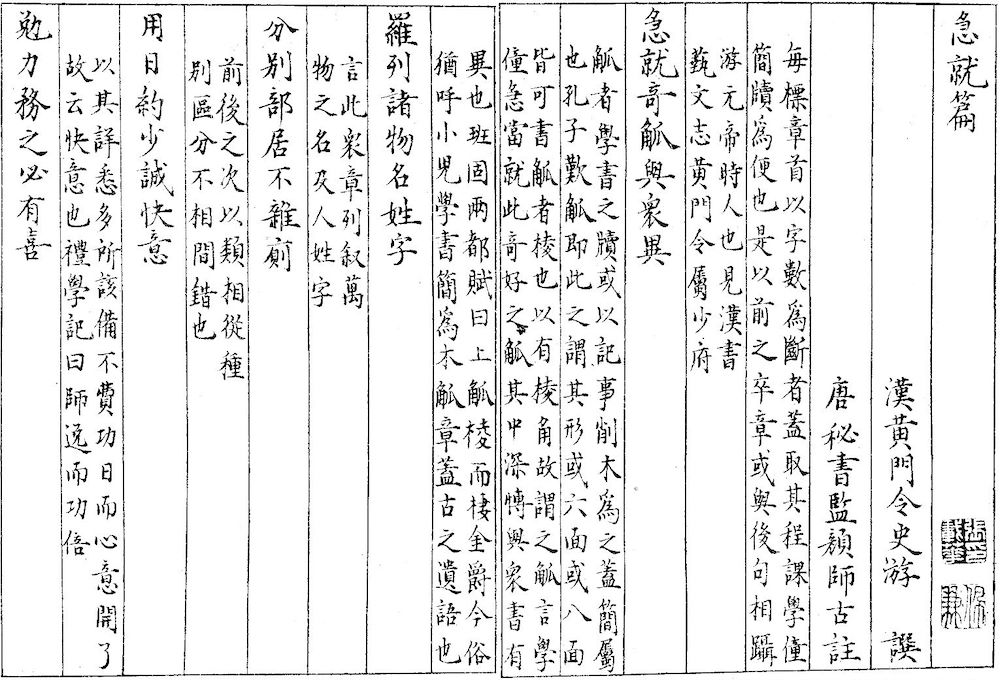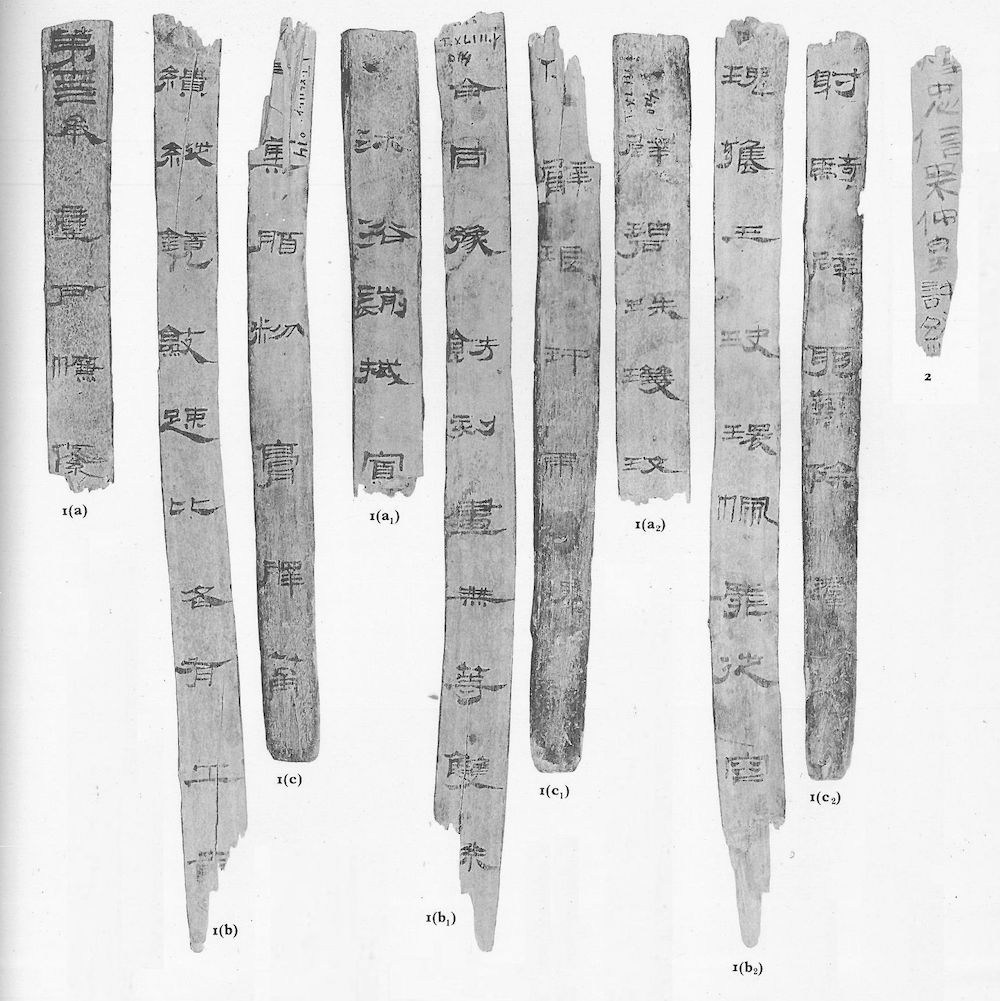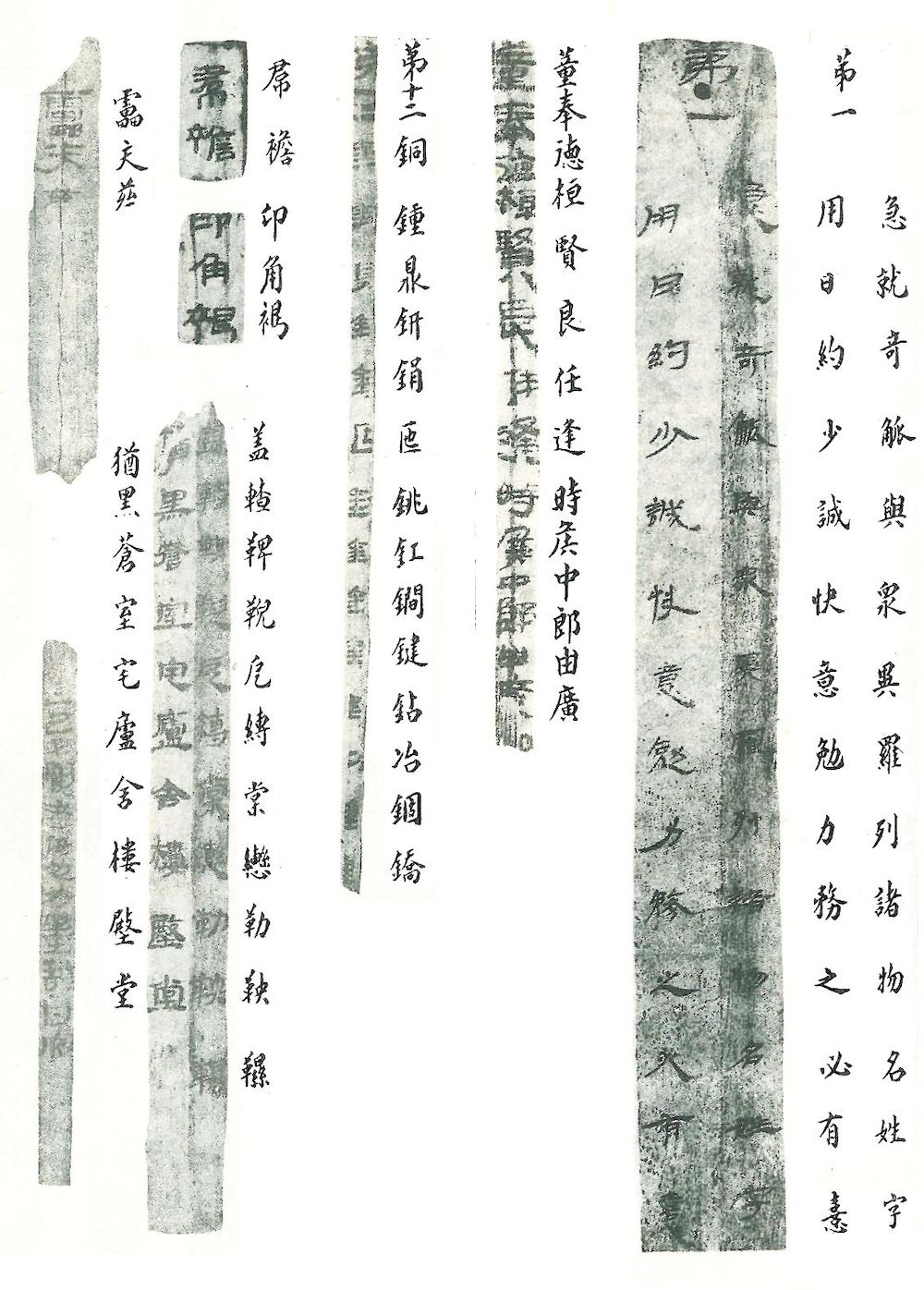Jijiupian 急就篇 "Quick access [to characters]" is a kind of character textbook from the Han period 漢 (206 BCE-220 CE) written by Shi You 史游 (c. 40 BCE). It is the only book of this type surviving. Others like Cangjiepian 倉頡篇, Xunzuanpian 訓纂篇, Fanjiangpiang 凡將篇 or Pangxipian 滂喜篇 are long since lost - apart from a few fragments.
 |
Beginning of the Jijiupian with the commentary of Yan Shigu 顏師古 (581–645), Sibu congkan 四部叢刊 edition, reproducing a Ming-period 明 (1368-1644) manuscript from the collection of the family Zhang 張氏 from Haiyan 海鹽, Zhejiang (Sheyuan Studio 涉園). Click to enlarge. |
The characters are learned through a rhyme system in which sentences of three, four or seven syllables or words are learned. The words to be learned are arranged in semantic groups which makes it easier to cover certain fields of characters to be learned. The Shijiupian is written in seven-syllable verses, but half of the text consists of personal names, which are grouped in three-character pairs.
羅列諸物名姓字。 分別部居不雜廁(=次)。 用日約少誠快意, 勉力務之必有喜。 請道其章。 |
[If you want to gain] quick access to outstanding polygonal slips*, different from the masses, [use this] listing of the characters of all objects and the personal names. [They are] classified into different sections, in order to prevent confusion in their arrangement. Daily and occasional consultation will result in great delight because [this arrangement] saves time and efforts and will bring enjoyment. Please use the stanzas [of this book] as a guideline. |
* Yan Shigu presents a lengthy explanation to the word gu 觚. It is a kind of writing slip made of bamboo or wood, and not flat, but rather round with six or eight edges and surfaces, and thus offered more pedagogical methods than the usual, flat slips. |
|
| 宋延年,鄭子方。衛益壽,史步昌。 | Song Yannian, Zheng Zifang. Wei Yishou, Shi Buchang [...] |
The first part of the text presents a large number of barely known personal names from ancient history. Song Yannian was a half-brother of King Zhou 紂 of the Shang dynasty, Zheng Zifang a son of King Li 周厲王 (r. 878-841 BCE) of the Zhou dynasty. In all these names, not a single character appears two times. |
|
| 姓名訖,請言物。 | Now the names are finished; let's talk about objects. |
| 錦繡縵䋃離雲爵(=孔爵=孔雀), 乘風縣鐘華洞(=通)樂。 |
Brocade, embroidery, plain cloth, stitching, clouds and phoenixes parting and twisting, [Patterns like] wind riders (seagulls) or bells hanging [on the rack], flowers stringed for music. |
| 豹首落莫兔雙鶴, 春草鷄翹鳧翁濯。 |
Tiger-head patterns overlying, forming the [shapes] of rabbits and pairs of cranes, [Patterns emerging like (or: green like)] spring grass, [coiled as (or: coloured like)] a cock’s tail, wetted like a [painted] duck’s neck. |
| 鬱金半見緗白䋤, 縹綟綠紈皁紫硟。 |
Deep yellow gold, half-saturated yellow, pure white; Greenish-white, blue-white, yellow-white, black, dark, violet, polished with stone. |
 |
Fragments of the Jijiupian, from the last fascicle, discovered in Dunhuang 敦煌. From Maspero (1953), Table I. Symbols of the transcription below: ■ character not readable, 〈 〉 only part of character preserved, 〔〕 addition to full verse, {} character variants not in Unicode. Some characters are different in the transmitted version (transm.) of the Jijiupian. |
| 2〈程〉忠信,吳仲皇,許終 〔古,賈友倉〕。 |
| 1(a)第十三(not transm.)。承塵戶𢅏絛/1(b)績縱。鏡斂(=奩)疎比各有(transm.異)工■(=芬)/1(c)𦸽(transm.薰)脂粉膏澤筩。/ |
| 1(a1)沐浴{長+前}(=揃)摵寡/1(b1)合同。豫(transm.襐)飭刻畫無等雙〈係〉/1(c1)臂琅玕虎(=琥) ■(=魄)〔龍〕。/ |
| 1(a2)辟(=璧)碧球璣玫/1(b2)瑰罋。玉玦環{珮-玉+巾}(=珮)靡從容。/1(c2)射騎(=鬾)辟耶除群兇(transm.凶) 。/ |
 |
Fragments of the Jijiupian, from Luo and Wang Guowei (1993). |
The Jijiupian was also used for calligraphic purposes, to train different styles of characters, like the chancery (lishu 隸書), documentary (zhangshu 章書) or "grass" (caoshu 草書) scripts. Even famous calligraphers like Wang Xizhi 王羲之 (303-361) or Zhao Mengfu 趙孟頫 (1254-1322) therefore calligraphed the textbook, and this is also a reason why it is preserved.
 |
Calligraphy of the Jijiupian, Ming-period rubbing of an engraving on a stone stele following the calligraphy of Huang Xiang 皇象 (3rd cent.), in documentary (zhangshu 章書) and chancery script (lishu 隸書), kept by the Songjiang Museum 上海市松江縣博物館. Zhongguo meishu quanji bianji weiyuanhui 1989, no. 18. |
The Tang-period 唐 (618-907) scholar Yan Shigu 顏師固 (581–645) and the Song-period 宋 (960-1279) scholar Wang Yinglin 王應麟 (1223-1296) wrote commentaries on the Jijiupian. It is included in the series Xiaoxue huihan 小學彙函 and Xuejin taoyuan 學津討原.